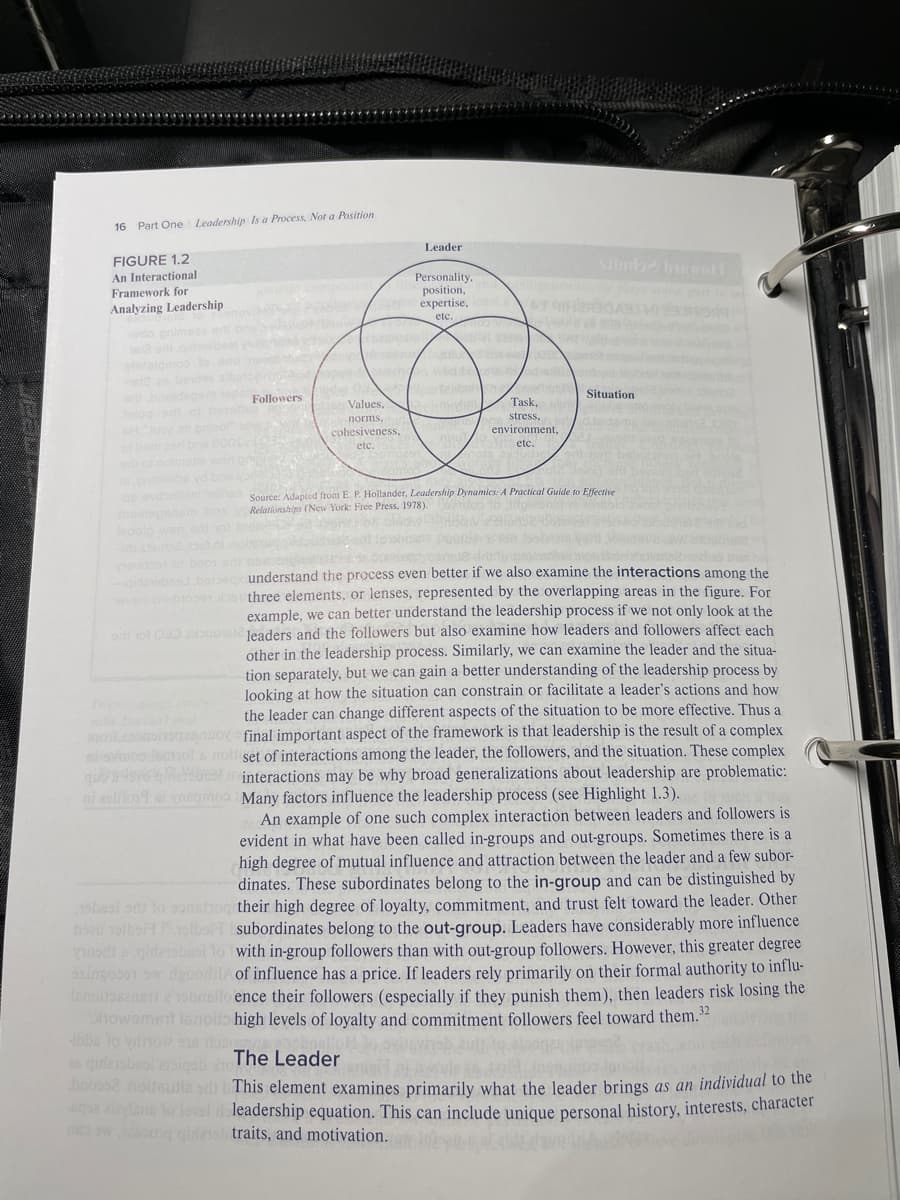To the extent that leadership is an art, what methods come to mind for improving one’s “art of leadership”? What characteristics of leaders, followers, and situations could you add to those listed in Figure 1.2 on page 16?
To the extent that leadership is an art, what methods come to mind for improving one’s “art of leadership”? What characteristics of leaders, followers, and situations could you add to those listed in Figure 1.2 on page 16?
Management, Loose-Leaf Version
13th Edition
ISBN:9781305969308
Author:Richard L. Daft
Publisher:Richard L. Daft
Chapter1: The World Of Innovative Management
Section: Chapter Questions
Problem 3DQ
Related questions
Question
100%
To the extent that leadership is an art, what methods come to mind for improving one’s “art of leadership”? What characteristics of leaders, followers, and situations could you add to those listed in Figure 1.2 on page 16?

Transcribed Image Text:16 Part One Leadership Is a Process, Not a Position
Leader
FIGURE 1.2
Ailu oll
Personality,
position,
expertise, BA
An Interactional
ences y
Framework for
Analyzing Leadership
etc.
vdo pnims
62 orgine
yistelgin
whd b
Situation
Followers
Task,
stress,
Values,
nlogod
norms,
cohesiveness,
environment,
etc.
etc.
Source: Adapted from E. P. Hollander, Leadership Dynamics: A Practical Guide to Effective
Relationships (New York: Free Press, 1978).
Inomepanem bn
lodolp wen on 1o
b surebeolno
evaoo bno
aiobss.bobex understand the process even better if we also examine the interactions among the
even ebiose oa three elements, or lenses, represented by the overlapping areas in the figure. For
example, we can better understand the leadership process if we not only look at the
or ol O0 budiole Jeaders and the followers but also examine how leaders and followers affect each
other in the leadership process. Similarly, we can examine the leader and the situa-
tion separately, but we can gain a better understanding of the leadership process by
looking at how the situation can constrain or facilitate a leader's actions and how
the leader can change different aspects of the situation to be more effective. Thus a
nolononsenuov final important aspect of the framework is that leadership is the result of a complex
noinoo ol s noltiset of interactions among the leader, the followers, and the situation. These complex
guờ sv minteractions may be why broad generalizations about leadership are problematic:
ai eolftor ai yasqunoo Many factors influence the leadership process (see Highlight 1.3).
An example of one such complex interaction between leaders and followers is
evident in what have been called in-groups and out-groups. Sometimes there is a
high degree of mutual influence and attraction between the leader and a few subor-
dinates. These subordinates belong to the in-group and can be distinguished by
obasl odi to soehon their high degree of loyalty, commitment, and trust felt toward the leader. Other
boa olbo rolboit subordinates belong to the out-group. Leaders have considerably more influence
10odsgideisbeol lo with in-group followers than with out-group followers. However, this greater degree
xingos ow dguodilA of influence has a price. If leaders rely primarily on their formal authority to influ-
lanoiosne hobnallo ence their followers (especially if they punish them), then leaders risk losing the
howamet lonoilo high levels of loyalty and commitment followers feel toward them.“
The Leader
26 qideobeol aroigab o
bnoos2.noitaulla sds bThis element examines primarily what the leader brings as an individual to the
aiadana to lovel d leadership equation. This can include unique personal history, interests, charactei
w giano traits, and motivation.
Expert Solution
This question has been solved!
Explore an expertly crafted, step-by-step solution for a thorough understanding of key concepts.
This is a popular solution!
Trending now
This is a popular solution!
Step by step
Solved in 3 steps

Knowledge Booster
Learn more about
Need a deep-dive on the concept behind this application? Look no further. Learn more about this topic, management and related others by exploring similar questions and additional content below.Recommended textbooks for you

Management, Loose-Leaf Version
Management
ISBN:
9781305969308
Author:
Richard L. Daft
Publisher:
South-Western College Pub

Management, Loose-Leaf Version
Management
ISBN:
9781305969308
Author:
Richard L. Daft
Publisher:
South-Western College Pub